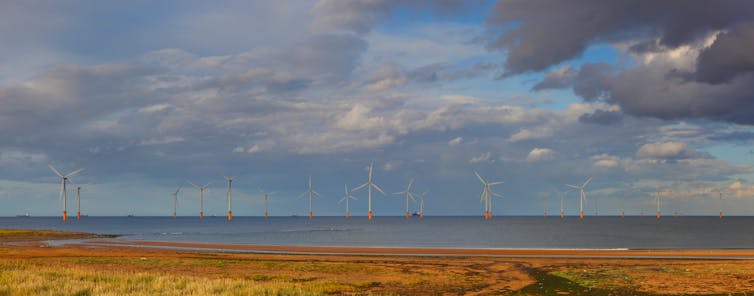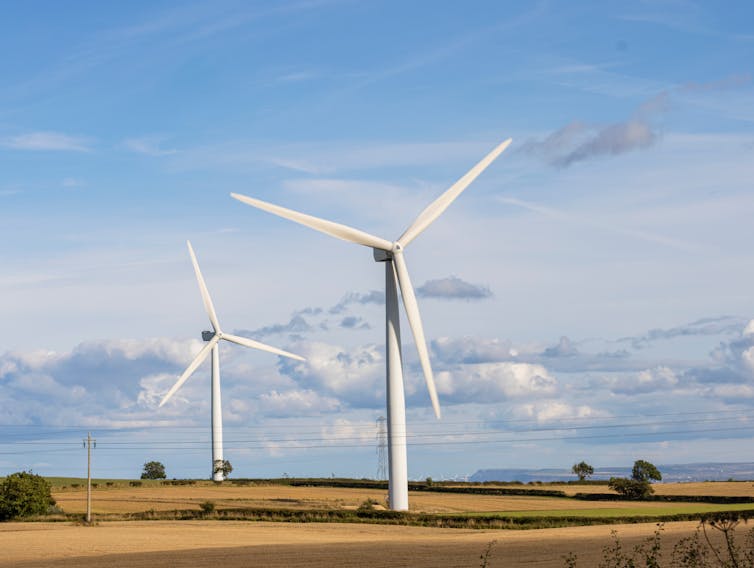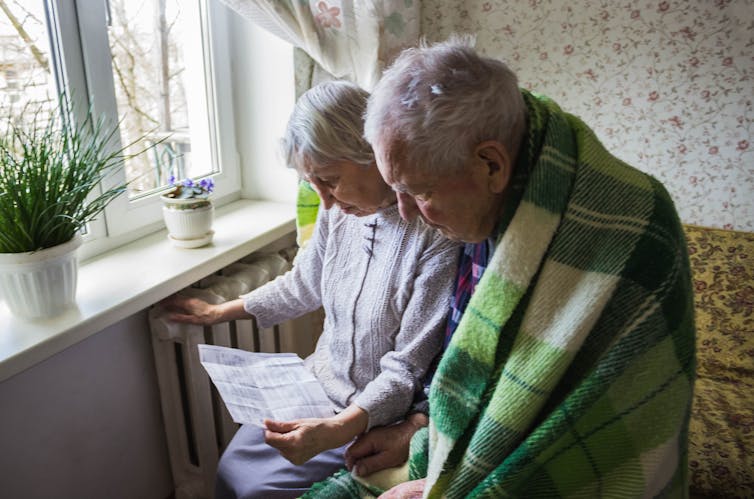Following a very successful three-day conference recently, I wanted to write a few words to extol the virtues of a hybrid meeting done really well. Lots of people at the moment are enthusing wildly about getting back to in-person meetings and general socialising, but not all of us are quite so excited about this return to the old world.
If this makes me a miserable old git, then so be it.
The meeting in question was a Galileo Conference, entitled ‘The warm Pliocene: Bridging the geological data and modelling communities’ and held virtually and in-person at the University of Leeds from 24-26 August 2022. It was sponsored by the NERC UK Integrated Ocean Drilling Programme, Past Global Changes (PAGES) and the European Geosciences Union (EGU), and was run by an organising committee led by Dr Aisling Dolan and Dr Heather Ford (from the University of Leeds and Queen Mary University of London, respectively). The conference website can be seen at https://www.egu-galileo.eu/gc10-pliocene/general_information.html. The conference focused on the mid-Piacenzian Warm Period (sometimes also known as the mid-Pliocene Warm Period, mPWP), an interval between approximately 3.3 and 3 million years ago when CO2 levels were roughly equivalent to today, global mean temperatures were 2-3°C higher than today and sea level was approximately 20 m higher than today. This makes it an important analogue for a possible future.
Normally, here, I would continue with the science, but that’s not the purpose of this post. The purpose of this post is the meeting itself. The meeting took a hybrid format, meaning there were approximately 50 people in the room and approximately 50 people joining virtually. I was in the latter group. For ease, I will refer to the former group as ‘reals’ and the latter group as ‘virtuals’; let’s not get into a philosophical discussion over the validity of these terms.
Since the beginning of the COVID pandemic in 2020, and even more so since its ‘supposed’ end in 2022 (not a statement I agree with, but I’m in a minority), I have attended a great number of virtual and hybrid meetings. Almost always, something has gone badly wrong; inadequate technology, glitching, freezing, inaudible lecturers, audio echoes, etc. However, ‘The warm Pliocene…’ meeting demonstrated that with the right technology and, more importantly, the right know-how to use it properly, a hybrid meeting can indeed be done perfectly. Here, I will cover the various elements of the meeting, how they have been done terribly in the past and how they were done flawlessly here.
Firstly, the main lectures (or short presentations), directed at everybody in the audience. This, in theory, should be the easiest part to arrange of any hybrid meeting. All that is needed is a camera (this is usually and most easily a laptop running Zoom, Teams or whatever, but could be a more sophisticated camera/microphone setup) pointing at the podium, a roaming microphone for the reals (so the virtuals can hear them), the slides shared via Zoom and a speaker (so the reals can hear the virtuals). Sounds simple, right?
Wrong.
Without mentioning any names of meetings and their organisers, I have lost count of the number of times I have spent the entire time staring either at the lecturer’s crotch, or the top of their forehead. Neither is particularly desirable. Three things are important here: the direction the camera is facing, the angle (i.e. vertically) the camera is facing and the distance between the camera and the lecturer. Get any of those wrong, and we are into crotch territory. The camera needs to be far enough away to see the whole person behind the podium, but not too far away for them to resemble a matchstick. It is not necessary to see the main screen at which the reals are looking, because the slides can easily be shared. So the reals see a person next to a large screen containing their slides, whereas the virtuals see the slides directly and then the lecturer as a thumbnail in one corner. Ideally, there needs to be a separate person dedicated to moving the camera/laptop; let’s call them the ‘controller’. The controller is not the lecturer or the Chair, but is solely responsible for moving the camera left, right, up or down so that it is always facing the lecturer during the talk and then the audience during the following questions/discussion. When anybody in the audience wants to speak, they use the same microphone that the lecturer was using.
Happily, the organisers of ‘The warm Pliocene…’ meeting got this spot on, constantly moving the laptop to the correct place depending on who was talking. The only thing that might have improved this would be to have a dedicated virtual constantly communicating with the controller (perhaps via the chat), to say whether the camera needs to be moved slightly; but this is only really necessary if the controller cannot see themselves.
As an aside, the concept of being moved around by someone else in order to see properly is unfamiliar to many people but, given my personal circumstances, is very familiar to me. Although most of the time I use an electric wheelchair and can therefore move myself, some of the time I use a manual wheelchair and therefore cannot. Given that I am not really able to turn my head from side to side, in order to see somebody or something I need to be directly facing them. I am therefore very used to asking “Please turn me a bit to the left” or similar. The difference between turning me in person (i.e. turning the wheelchair) and turning me virtually (i.e. turning the laptop) is exactly what?!
Secondly, the poster sessions. If you are at any train station or airport, anywhere in the world, and you see a bunch of nerdy-looking people holding long cardboard or black plastic tubes, you can be sure there is a conference somewhere nearby. Traditionally, the idea is the poster is physically printed and displayed in a large room, and the author stands next to it at the allocated time and talks to people walking by. This, in theory, is not so easy to do in the virtual space; again I have lost count of the number of failures using Zoom, where people haven’t known how to use the breakout room function, people have been lost in virtual space or people have all tried to talk at once.
Or, the now famous “You’re on mute”.
However, again, happily the organisers of ‘The warm Pliocene…’ meeting got it right. There was a combination of traditional and virtual poster sessions; for the former, the reals were able to interact in the old-fashioned way, whereas the virtuals were able to view the posters that had been uploaded, in advance, to Padlet, as well as a two minute introductory talk that had been pre-recorded by the authors. The virtuals could then post questions on Padlet, which could be answered by the author either instantly or later on. For the virtual poster sessions, both the reals and the virtuals operated in virtual space; the reals were told to find a quiet corner of the conference centre and interact virtually using Zoom, whereas the virtuals were already on Zoom. Within this virtual space, every poster presenter was assigned their own breakout room, where they would wait patiently for the audience to drop by. Everybody could see a list of the breakout rooms, and could therefore choose to whom they wanted to talk. If there was more than one person in a given breakout room, they would simply wait their turn to talk to the presenter; much like they would if they were they standing in a crowd around a physical poster and presenter.
As I always tell my students, presenting a poster is actually a lot more hard work than giving a talk, and this is true in both the real and virtual world.
Thirdly, the discussion and breakout groups. Again, in theory, this is not so easy to get right in the virtual world. This is usually because of two reasons. Firstly because of the same problem as above i.e. the breakout room function not being used correctly, and people not knowing whether they were supposed to be in the main virtual room or in a breakout room. But secondly, because of people basically not knowing how to use Zoom. As time goes by this is becoming less of a problem, but at the beginning it was ridiculous. Almost every virtual meeting I attended in the first couple of years of the pandemic – and don’t forget that most of these were academic meetings, so everybody has a brain the size of a planet (except me, obvs, as I am always the dummy in the group) – began with everybody shouting “Can you hear me?” for the first ten minutes.
However, once more, the organisers of ‘The warm Pliocene…’ meeting managed to arrange everything seamlessly. There was in a little bit of confusion, at the beginning of the first day, as to exactly which breakout room the virtuals were supposed to use, but that was quickly resolved and the rest of the days went very smoothly. The reals were divided into groups of four or five, including a member of the organising committee who was responsible for leading the discussion, taking notes and then reporting back to everybody at the end. Likewise the virtuals were divided into similar-sized groups and assigned to a breakout room, again with a member of the organising committee taking the lead. After half an hour or so of discussion, everybody would return to the main room i.e. the reals would stop talking amongst themselves and turn back to the main screen and podium, whereas the virtuals would return to the main virtual room, which was again facing the main screen and podium. People would then report back, either in person or virtually. Given that the reals all used a roaming microphone when speaking, and the virtuals were projected visually on the main screen and audibly via the speaker system, everybody was able to hear everybody and a normal discussion could be had, whether real or virtual.
Lastly, the only part of the conference which, sadly, is almost impossible to translate to the virtual space is the socialising and indeed the scientific conversations had during these times, either over coffee, lunch or during the evenings. I do not doubt that one day we will have Star Wars-style holographic projections on a small floating platform, meaning that in any given setting (such as round the restaurant table, or standing at the bar), there will be a mixture of real people and holograms that can interact as if they were physically present.
But we are not there yet.
In the meantime, this is probably the one and only part of a conference or scientific meeting in which the virtuals cannot fully participate. I have had meetings where there has been an attempt at this, such as after the meeting where the virtuals are told to get a drink and then chat to each other via Zoom breakout rooms. But this never works particularly well; either because there are too many people in one breakout room, meaning everybody talks at once or just a handful dominate the conversation, or because the organiser assigns people randomly to a breakout room, meaning you get stuck with a bunch of people you have never met and would possibly never choose to meet. In the real world, over coffee, you can choose with whom you chat, or you can choose to sit in the corner and be unsociable. In the virtual world, you can do neither.
Chit-chat or small talk always makes me uncomfortable, and this is exaggerated in virtual space.
To summarise, therefore: ‘The warm Pliocene…’ meeting was a masterclass in how to get a hybrid meeting right. I firmly believe that the main reason it was so successful, for both reals and virtuals, is that (like in many aspects of life) it was completely inclusive. I have been to several hybrid meetings where the virtual attendees are treated a little bit like second-class citizens, allowed to say their piece at the appropriate time but otherwise supposed to be quiet, because they are not really there, are they? This is a shame, but common. Sometimes it is completely unintentional, just an artefact of the organisers being too preoccupied with people actually in the room to remember about those who are not. A lot of my friends and colleagues argue that attending a meeting virtually is not the same, but I completely disagree. It is not the same if the hybrid part is done badly, yes. But, as the organisers of ‘The warm Pliocene…’ meeting have shown, when it is done well, a hybrid meeting can be as enjoyable, if not more enjoyable, than being there in-person.
I want to finish with just a few, more general thoughts concerning fully virtual, hybrid or fully in-person conferences and meetings. Moreover, some thoughts on how these principles translate into our university teaching, which was obviously 100% in-person before the pandemic, then out of necessity became 100% virtual and now is moving back towards the old world i.e. 100% in-person.
I should stress that I completely understand the vast majority of people who are very happy to go back to the old world, be that at work attending in-person meetings or generally socialising. Concerning teaching, I completely understand that many students struggled during the various lockdowns of 2020 and 2021, and that many are very happy and indeed keen to go back to the traditional way of teaching. This has resulted in a push, by most universities, to return to 100% in-person teaching as soon as possible. But this university-wide policy has often resulted in a new reluctance, by many university IT departments, to invest in new technology to allow better hybrid meetings. This, in my humble opinion, is very misguided. We know, now, that virtual and hybrid meetings are possible, work well and, when done correctly, can be preferable for some. To abandon this experience and technology in favour of the traditional way is a very big mistake. There are three reasons why I believe this.
Firstly, it doesn’t take a genius to work out that the next global pandemic is only around the corner. This is not being pessimistic, but rather realistic. The scientific community knew, way back in the 1980s, that concerning impact versus likelihood of occurrence, a global pandemic came first amongst all other natural and man-made disasters, as having both the highest impact and the highest likelihood. But, when it did happen almost 40 years later, we were still not ready for it. If we abandon our new experience of virtual and hybrid meetings and teaching, and do not invest in the technology to make this better, we will be caught with our trousers down once again.
Secondly, for the vast majority of the world (or rather, the Western world – much of the Global South is still suffering massively), COVID is over. This is either because most people have had it and it wasn’t too bad, or most people are not vulnerable to it and don’t know anyone who is, or most people have had several doses of the vaccine and therefore (incorrectly) think they are completely shielded from it, or most people became so fed up with the restrictions that they simply don’t care anymore. Either way, the fear (often of the unknown) has gone. However, for some people – not many, but a significant minority – COVID is very much not over. This might be because they are elderly, immunosuppressed or, like myself, have some other underlying condition which means they are still highly vulnerable to any respiratory-related disease. For those people, COVID is still very much a real and present danger. For those people, like myself, who have not yet caught COVID (or, at least, not that I know of) because of their super-cautious behaviour and actions – which is often disapproved of and ridiculed by even close friends and family, “You’ve just got to learn to live with it” – the fear of the unknown is still very much there. Therefore, if we abandon virtual and hybrid meetings and teaching, there is a real risk that this significant minority will feel even more marginalised and excluded than they did before the pandemic.
Likewise, concerning teaching, although most students appear to prefer the traditional way, this is not a constant. Based on my conversations with them, many students quite like a mixture of in-person and virtual lectures, seminars and discussions. This might be for health reasons, or because they quite like the anonymity of being behind a screen. When I was an undergraduate, over 20 years ago, if I had had the option of watching my 9 AM lecture in my pyjamas at home or making the 20 minute, bleary-eyed walk onto campus and into a cold lecture theatre, I know exactly what I would have chosen. Moreover, for those students who need to have difficult conversations with their tutors – possibly bursting into tears because they did not get the grades they wanted – doing that over Zoom is, I would imagine, far more of a safe space than doing it in the tutor’s office. To completely abandon virtual and hybrid communication would, therefore, marginalise these students as well. Instead, the option of doing things virtually should be made available, now that we know it is a viable option.
Lastly, there is the issue of travel, which is more relevant to the scientific meeting or conference than it is to teaching. This is particularly relevant to those in my profession; as somebody once said, climate scientists fly all over the world telling people not to fly all over the world. This is something of which we have all been guilty. Now, however, we don’t need to do this. As long as whatever meeting or conference is prepared to put the technology and know-how to good use, I can attend any meeting I like, anywhere in the world, with minimal effort and zero carbon emissions on my part. I agree, it is not quite the same and you certainly don’t get the change of scenery, but surely it is better, from an environmental perspective, than the old way? Returning to ‘The warm Pliocene…’ meeting, it was not a large international conference involving thousands of people, but rather a relatively small meeting and workshop. It was, however, international, and we had participants from all over the world. For them to fly all the way to the UK for just three days, when they were able to participate fully in virtual space, is nonsense and goes against everything we are trying to preach.
So, in summary, virtual and hybrid meetings are not only possible, but can actually be preferable when done really well, as the recent masterclass demonstrated. To abandon everything we have learnt over the last three years, in the knowledge of what it would do to a significant minority and the knowledge of what is probably going to happen in the future, would be utterly foolish.
———————————-


![]()












